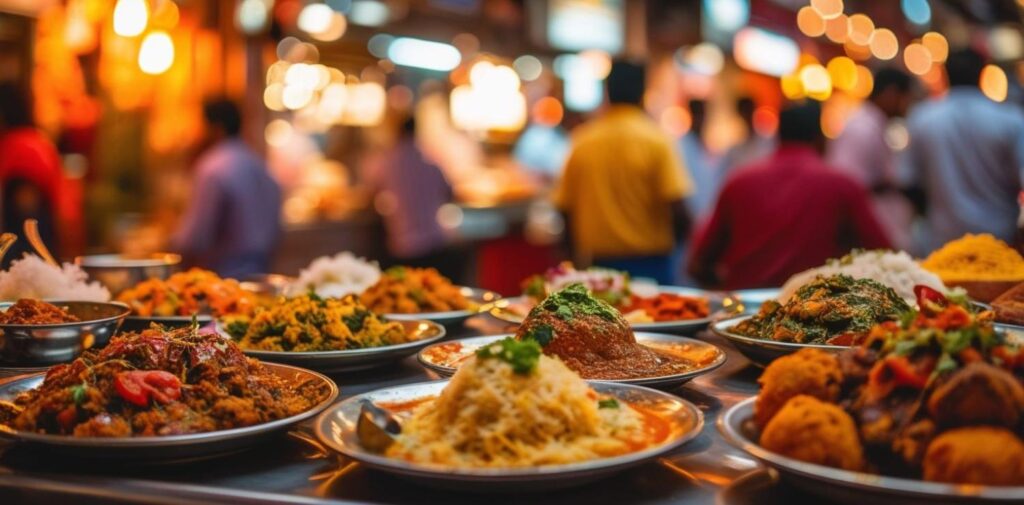India, a land of diverse cultures, languages, and traditions, is also home to an incredibly varied and rich culinary heritage. In recent years, there has been a surge in the global travel industry towards culinary tourism, and India has emerged as one of the most sought-after destinations for food lovers. Indian Culinary tourism refers to traveling to experience and enjoy the local cuisine and food culture of a particular region. This growing trend is not just about tasting food but about immersing oneself in the history, culture, and traditions that shape the food of a region. Indian cuisine, with its deep roots in history and regional diversity, has become a key player in this global phenomenon.
India’s Culinary Diversity: A Global Attraction
India’s culinary landscape is as diverse as its culture. From the rich, spicy curries of the North to the coconut-infused flavors of the South, from the street food stalls of Mumbai to the royal kitchens of Rajasthan, every region in India offers something unique. This diversity is what makes India an attractive destination for culinary tourism. Whether it is the aromatic biryanis of Hyderabad, the sweet delicacies of Bengal, or the coastal flavors of Kerala, there is something for everyone.
Each state in India has its own set of ingredients, cooking techniques, and special dishes that reflect the local culture and history. This makes Indian cuisine a rich tapestry of flavors that are bound to entice food enthusiasts from all over the world. Tourists who visit India not only come to enjoy the food but also to understand the stories behind these dishes. They want to learn how the food has evolved over centuries and how it ties into the local traditions and festivals.

Street Food: A Taste of India’s Heartbeat
One of the most exciting aspects of Indian culinary tourism is its vibrant street food culture. Street food is not just about food; it’s about experiencing the energy and buzz of India’s cities and towns. Cities like Delhi, Mumbai, Kolkata, and Amritsar are known for their bustling street food scenes, where vendors serve everything from spicy chaat (snacks), to savory kebabs, to crispy dosas.
Street food has become a major attraction for culinary tourists. Many food tours around India focus specifically on street food, taking visitors through narrow lanes and local markets to discover hidden gems. It’s here that tourists can truly taste the soul of India. The food is often cooked in front of them, giving them the opportunity to interact with the vendors and learn more about the local ingredients and cooking methods. The experience is as much about the atmosphere and the stories behind the food as it is about the taste.
Culinary Tours: Learning the Art of Indian Cooking
As culinary tourism in India grows, more and more tourists are looking to do more than just eat—they want to learn how to cook. This has led to the rise of culinary tours across the country. These tours not only involve visiting famous food spots but also provide hands-on cooking classes, where tourists can learn how to make popular Indian dishes from scratch.
From cooking classes in the royal kitchens of Rajasthan to hands-on workshops in the villages of Kerala, culinary tours in India offer an authentic experience. Tourists get the chance to learn the secrets of Indian spices, the art of making the perfect curry, and the techniques used to create traditional sweets like gulab jamun and laddoos. Many of these tours are guided by local chefs who share their family recipes, which have been passed down through generations. This not only helps tourists take home the knowledge of Indian cooking but also makes them feel connected to the culture.

Ayurvedic and Healthy Indian Food Tourism
With the rise of health-conscious tourists, Ayurvedic and healthy food tourism has become a significant trend in India. Ayurvedic cuisine, which focuses on balancing the body’s three doshas (Vata, Pitta, and Kapha), has gained popularity in recent years. Ayurvedic food emphasizes fresh, seasonal ingredients and simple, wholesome meals designed to promote health and wellness.
Many wellness resorts and retreats in India now offer Ayurvedic cooking classes as part of their holistic health packages. These classes teach tourists how to prepare balanced, nutritious meals that are in harmony with nature. This has attracted a large number of international tourists who are interested in incorporating Ayurvedic principles into their diet and lifestyle. States like Kerala and Uttarakhand, known for their Ayurvedic therapies, have become popular destinations for those looking to explore the intersection of food and wellness.
The Role of Food Festivals in Culinary Tourism
India is home to numerous food festivals, where culinary tourism reaches its peak. These festivals celebrate the diverse regional flavors and traditional cooking techniques of India. From the annual Street Food Festival in Delhi to the Rajasthani Food Festival in Jaipur, these events allow visitors to sample a wide variety of dishes in one place. Food festivals provide a platform for local chefs and home cooks to showcase their talents and introduce tourists to authentic, lesser-known regional cuisines.
One of the most famous food festivals in India is the Goa Food and Cultural Festival, which draws food lovers from all over the world to experience the best of Goan cuisine. Similarly, the International Mango Festival in Delhi celebrates India’s most beloved fruit with a focus on the many ways mangoes are used in Indian cooking. These festivals not only provide a feast for the senses but also promote local food cultures and traditions to a global audience.

Sustainability and Ethical Tourism in Indian Culinary Travel
As the culinary tourism industry grows, there is also a growing awareness of sustainability and ethical food practices. Tourists are increasingly seeking out experiences that promote the use of local, organic, and sustainable ingredients. Many food tours and cooking classes now focus on the importance of supporting local farmers and artisans.
Sustainable food tourism is particularly prominent in India’s rural regions, where organic farming and the use of traditional, eco-friendly cooking methods are gaining attention. Many culinary tours now include visits to local farms, where tourists can learn about the cultivation of ingredients like spices, grains, and vegetables that are essential to Indian cuisine. This approach helps promote the importance of sustainable food practices while allowing tourists to enjoy fresh, locally sourced food.
Conclusion: The Future of Indian Culinary Tourism
The rise of culinary tourism in India is a testament to the country’s rich food heritage and the growing global demand for authentic travel experiences. As more travelers seek to explore food cultures and traditions, India’s diverse culinary offerings will continue to attract tourists from around the world. With its rich history, vibrant street food culture, unique cooking styles, and focus on wellness, India is poised to become a global leader in culinary tourism.
For food lovers and travel enthusiasts alike, India offers an unforgettable journey through the flavors of its past and present. From savoring street food to learning the secrets of traditional cooking, culinary tourism in India is an experience that nourishes the body, mind, and soul. As this trend grows, it’s clear that the flavors of India will continue to captivate travelers for years to come.




